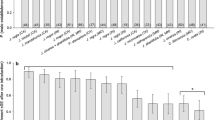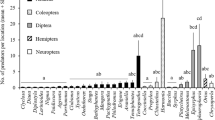Abstract
The North American noctuidmoth Bellura densa offers promise as abiological control agent for use in Africa andother countries invaded by water hyacinth. Anaugmentative release at a pond in Florida, USA,eliminated water hyacinth within a few months. Laboratory studies, though, indicated thatoviposition was indiscriminate and thatdevelopment was completed on taro (Colocasia esculenta [Araceae]) as well as onseveral Pontederiaceae. Acceptability of taroas a larval food plant was confirmed in thefield when larvae were found in isolated standsof taro in Florida. Evidence of use of Peltandra virginica (Linnaeus) (Araceae) wasnoted at another site. The distribution oflarval damage was compared at a site containinga mixture of 97% taro and 3% pickerelweed(Pontederia cordata). Larvae damaged87% of the pickerelweed compared to only about5% of the taro, suggesting spillover ontotaro. In another study, 416 larvae wereliberated into a concrete tank containing waterhyacinth (818 plants) surrounded by taro (96plants). Three months later, taro accountedfor only 4% of the damaged plants, less thanthe 11% expected if host selection had beenrandom. In a similar study, larvae wereliberated onto water hyacinth in a large tankdivided into thirds, with pickerelweed or taroat either end and water hyacinth in the middle. The distributions of F1 egg masses andincidence of damage 3 months later indicatedthat pickerelweed was preferred over taro, but26% of the taro plants were damaged. Weconclude that while B. densa prefersplants in the Pontederiaceae, it is notrestricted to this plant family. Plants in theAraceae would be at risk if this insect werereleased outside of North America, particularlyin cropping situations near water hyacinthinfestations. Bellura densa could beuseful for water hyacinth management in theU.S. if effective augmentation strategies weredeveloped.
Similar content being viewed by others
References
Baer, R.G. and P.C. Quimby, Jr., 1981. Laboratory rearing and life history of Arzama densa, a potential native biological control agent against waterhyacinth. J. Aquat. Plant Manage. 19: 22–26.
Baer, R.G. and P.C. Quimby, Jr., 1982. Some natural enemies of the native moth Arzama densa Walker on waterhyacinth. J. Georgia Entomol. Soc. 17(3): 321–327.
Center, T.D., 1976. The potential of Arzama densa (Lepidoptera: Noctuidae) for control of waterhyacinth with special reference to the ecology of water hyacinth(Eichhornia crassipes (Mart.) Solms.). PhD Dissertation, University of Florida, Gainesville, FL. 334 pp.
Julien, M.H. and M.W. Griffiths, 1998. Biological Control of Weeds: A World Catalogue of Agents and Their Target Weeds, 4th ed. CABI Publication, London, U.K. 223 pp.
Julien, M.H., K.L.S. Harley, A.D. Wright, C.J. Cilliers, M.P. Hill, T.D. Center, H.A. Cordo and A.F. Cofrancesco, 1996. International co-operation and linkages in the management of water hyacinth with emphasis on biological control. In: V.C. Moran and J.H. Hoffmann (eds), Proceedings of the IX International Symposium on Biological Control ofWeeds, 19–26 January 1996, Stellenbosch, South Africa. University of Cape Town, Publ. pp. 273–282.
Habeck, D.H., 1974. Arzama densa as a pest of dasheen. Fla. Ent. 57(4): 409–410.
Hill, M.P. and C.J. Cilliers, 1999. A review of the arthropod natural enemies, and factors that influence their efficacy, in the biological control of water hyacinth, Eichhornia crassipes (Mart.) Solms-Laubach (Pontederiaceae) in South Africa. So. Afr. Entomol. Mem. 1: 103–112.
Levine, E., and L. Chandler, 1976. Biology of Bellura gortynoides (Lepidoptera: Noctuidae), a yellow water lily borer, in Indiana. Ann. Entomol. Soc. Am. 69(3): 405–414.
Penko, J.M. and D.C. Pratt, 1986. The growth and survival of early instars of Bellura obliqua (Lepidoptera: Noctuidae) on Typha latifolia and Typha angustifolia. Great Lakes Entomol. 19 (1): 35–42.
Sokal, R.R. and F.J. Rohlf, 1981. Biometry. W. H. Freeman and Co., New York. 859 pp.
Vogel, E. and A.D. Oliver, Jr., 1969a. Evaluation of Arzama densa as an aid in the control of waterhyacinth in Louisiana. J. Econ. Entomol. 62(1): 142–145.
Vogel, E. and A.D. Oliver, Jr., 1969b. Life history and some factors affecting the population of Arzama densa in Louisiana. Ann. Entomol. Soc. Am. 62: 749–752.
Author information
Authors and Affiliations
Corresponding author
Rights and permissions
About this article
Cite this article
Center, T.D., Hill, M.P. Field efficacy and predicted host range of the pickerelweed borer, Bellura densa, a potential biological control agent of water hyacinth. BioControl 47, 231–243 (2002). https://doi.org/10.1023/A:1014579406894
Issue Date:
DOI: https://doi.org/10.1023/A:1014579406894




